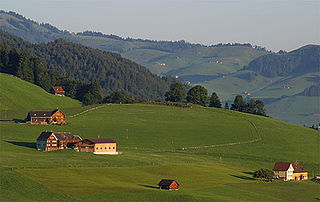| Šmihel Sveti Mihael (until 1955) | |
|---|---|
| Coordinates: 45°57′4.17″N13°43′31.43″E / 45.9511583°N 13.7253972°E Coordinates: 45°57′4.17″N13°43′31.43″E / 45.9511583°N 13.7253972°E | |
| Country | |
| Traditional region | Slovenian Littoral |
| Statistical region | Gorizia |
| Municipality | Nova Gorica |
| Area | |
| • Total | 5.22 km2 (2.02 sq mi) |
| Elevation | 184.6 m (605.6 ft) |
| Population (2002) | |
| • Total | 266 |
| [1] | |
Šmihel (pronounced [ˈʃmiːxɛu̯] ; Italian : San Michele) is a dispersed settlement in the Municipality of Nova Gorica in western Slovenia. [2] It is located in the lower Vipava Valley.

Italian is a Romance language. Italian, together with Sardinian, is by most measures the closest language to Vulgar Latin of the Romance languages. Italian is an official language in Italy, Switzerland, San Marino and Vatican City. It has an official minority status in western Istria. It formerly had official status in Albania, Malta, Monaco, Montenegro (Kotor) and Greece, and is generally understood in Corsica and Savoie. It also used to be an official language in the former Italian East Africa and Italian North Africa, where it plays a significant role in various sectors. Italian is also spoken by large expatriate communities in the Americas and Australia. In spite of not existing any Italian community in their respective national territories and of not being spoken at any level, Italian is included de jure, but not de facto, between the recognized minority languages of Bosnia-Herzegovina and Romania. Many speakers of Italian are native bilinguals of both standardized Italian and other regional languages.

A dispersed settlement, also known as a scattered settlement, is one of the main types of settlement patterns used by landscape historians to classify rural settlements found in England and other parts of the world. Typically, there are a number of separate farmsteads scattered throughout the area. A dispersed settlement contrasts with a nucleated village.

Nova Gorica is a town and a municipality in western Slovenia, on the border with Italy. Nova Gorica is a planned town, built according to the principles of modernist architecture after 1947, when the Paris Peace Treaty established a new border between Yugoslavia and Italy, leaving nearby Gorizia outside the borders of Yugoslavia and thus cutting off the Soča Valley, the Vipava Valley, the Gorizia Hills and the northwestern Karst Plateau from their traditional regional urban centre. Since 1948, Nova Gorica has replaced Gorizia as the principal urban centre of the Goriška or Gorizia region, as the northern part of the Slovenian Littoral has been traditionally called.










